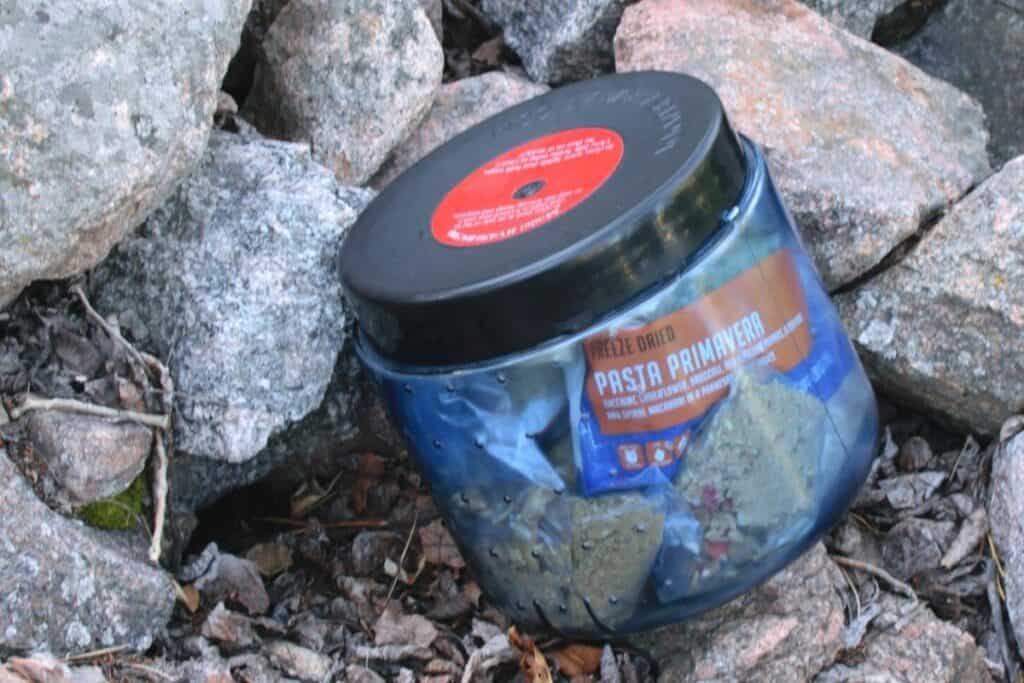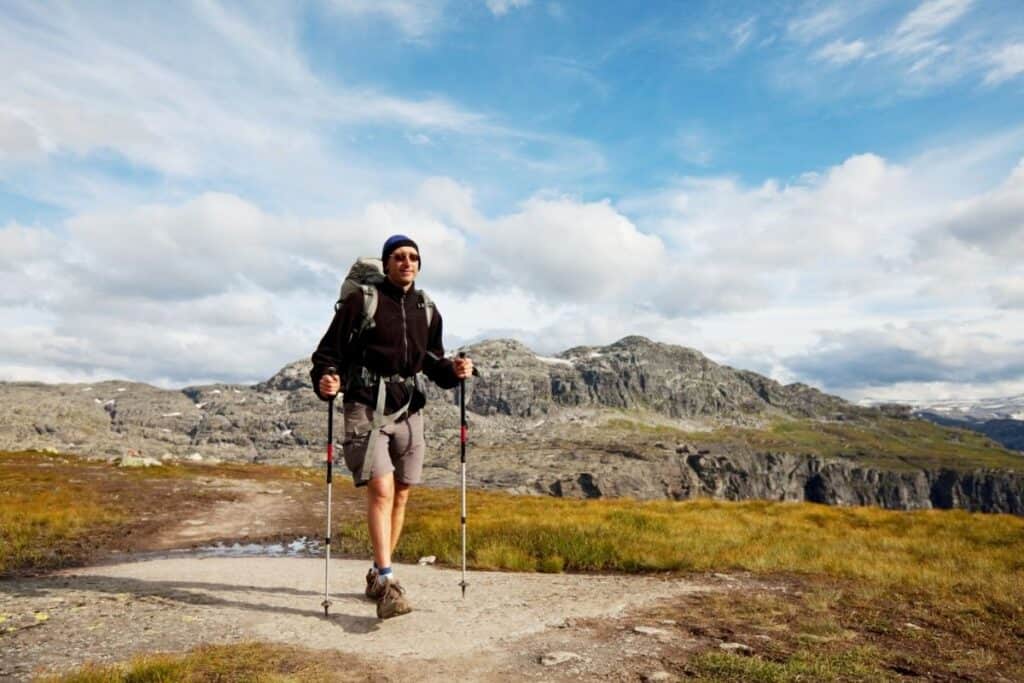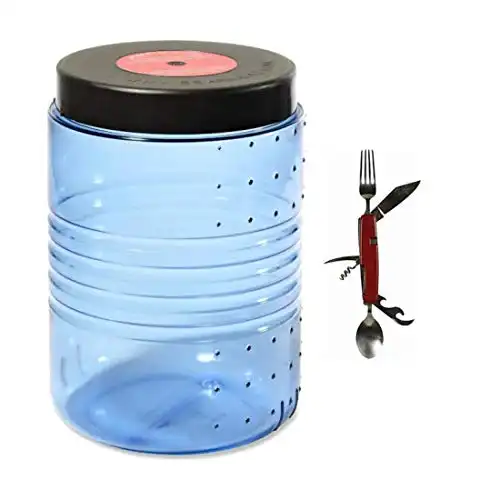
If you plan on visiting in an area with active bears, then you may find yourself wondering if a bear canister is needed for a day hike. After all – no one wants to risk an encounter with a bear if they don’t need to!
Bear canisters are generally not necessary for day hikes. However, they should be used when performing overnight or multi-day trips through areas with active bear populations.
With that in mind, let’s take a look a both the advantages and disadvantages to using a bear canister for hikes.
Disadvantages to Taking a Bear Canister On A Day Hike
While you’re highly unlikely to be attacked by a bear, which we’ll get to later, a bear canister won’t hurt you that much. If you’re willing to lug around the extra weight, all the more power to you!
Bulk
Whereas the bulk added by a bear canister can be brush doff on a longer hike, hikers only going out for a day might find all the added weight and space quite cumbersome.
Your average bear canister will add somewhere around two pounds to your total carry, which doesn’t sound like much, but can affect your speed and agility while you’re on rough terrain.
Bear canisters are also very rigid objects. Unlike plain plastic bags or other forms of storage, bear canisters have no give and won’t shift around to fit the inside of your backpack.
With just a few cliff bars and a water bottle full of Gatorade to store, what’s the use? You’re better off keeping your backpack close and keeping your eyes peeled for animals.
Unnecessary Protection
Don’t get me wrong; bear safety is always the best choice for hikers who want to keep ahold of their limbs. However, in the case of unattended food, you may want to just let a bear have it if he should find it.
Bears are intelligent, persistent creatures who are used to having to flush food out of tricky spots. With courage and determination like this, who’s to say a bear will pass along like it saw nothing if you let it at your canister?
The internet is littered with videos of bears trying relentlessly to open bear canisters. If a bear is particularly hungry, you may have to wait a long time far out of his line of sight for him to finish trying to decode your canister.
In this situation, you may end up wishing he could have simply gotten to the cliff bars and gotten it over with. Now, you’re waiting on him to finish what he started and move on- on his own time.
Again, to prevent incidents like this, you need to keep your backpack in close proximity.
It’s not hard to keep your bag attended throughout the day, and it will keep less dangerous animals like raccoons and squirrels away from your valuable cargo.
You can also take along a rope and carabiner to hang your backpack in a tree while you swim or relieve yourself.
This is a lot of work for a short dip or a trip to go number one, but it will keep animals away from your pack and keep the scent of your food elevated to avoid unwanted visits!
Advantages to Taking a Bear Canister On A Day Hike
Before you write this one off, let’s also look at the advantages that do exist for using a bear canister on a day hike.
Protection
You should never leave your backpack unattended while you’re in the wilderness, as hungry animals lurk throughout the brush. If you have to, though, a bear canister can help you keep your foods safe and sound in the event of a bear encounter.
If your food is on your back, bears will most likely not approach you. However, leaving your pack in a field or on a beach when you go swimming or are otherwise distracted can make them more vulnerable.
In this case, a bear will paw around your pack, possibly rip it open, and if your foods are exposed, it will help itself. You won’t be able to get to your pack until the bear leaves, which can seriously slow you down and even possibly keep you out past sundown.
A bear canister will prevent this, frustrating the bear’s efforts to obtain your food and making them more likely to pass along without scarfing down your ramen.
Organization
Not all bear canister advantages have to do with bears. While bear canisters will ward off hungry animals, they can also carry lots of food, and fit snugly inside a backpack or other carrying mechanism.
Think of the last time you packed your bag for a day hike: were there Cliff bars scattered all over the bottom? Did your food get mixed up with your water and medkit?
Maybe, one of your bags burst, sending granola and beef jerky all throughout the nooks and crannies inside.
With a bear canister, you can avoid all of this. Bear canisters have capacities as high as a week’s food storage and are a great way to keep your loose foods contained on a day hike, especially if all you have are power bars and granola.
With a bear canister, you won’t have to worry about spillage or bent granola bars.

When to Bring a Bear Canister
With all of these solutions to the age-old bear problem, it’s easy to see why most hikers choose to skip out on bear canisters when they’re only planning on an hour-long outing.
However, bear canisters offer hikers distinct advantages and are highly useful on certain kinds of hikes. Without them, valuable food is vulnerable to theft and pillaging, and hungry bears might find a meal at your camp.
If you’re going on an overnight trip, tents and all, you’re going to want a bear canister. Bears are most active at night when it comes to foraging for human food, so this is a key time that you’ll want to make sure that your food stash is protected!
Combine a bear canister with smell-proof packaging and a sturdy hang from a high branch, and you most likely won’t have to worry about your furry friends.
The organization a bear canister affords can also help you to keep your pack in line. Bear canisters can reduce litter by holding trash for the time being and can keep foodstuffs from scattering all over the inside of your backpack.
Compared to other hiking/camping equipment, bear canisters are relatively inexpensive. If you only expect to use them once or twice, you may want to consider renting or borrowing one.
However, if you do choose to purchase a bear canister then the good news is that you’ll be set for years to come. They’re extremely simple devices and well-built – meaning that they’ll last a while.
For their durability and comparatively lighter weight, I’m a fan of the BearVault models. Their clear plastic construction also makes it easy to see where items are inside of the canister instead of needing to remove everything to located a single item when you’ve got it packed tightly.
Camp without worry with the Bear Vault Bear Resistant Food Container. These lightweight canisters are super rugged and can hold up to 7 days worth of food. The polycarbonate material resists shattering upon impact, which adds to the durability of this container.
A new, high-grade bear canister, however, can run you up as much as $80! If you’re looking for a surefire way to keep bears out of your food, however, you’ll want to make an investment.
Are Bear Canisters Smell-Proof?
Unfortunately, bears can smell your food even through your bear canister. This doesn’t mean there’s no way to keep the odors down. It just means you’ll have to employ other methods to do so.
When I go on my hiking trips, I like to take two Ziploc bags, put my food in one, suck the air out, and then wrap the whole thing in another bag. Once the item are wrapped you can then place them inside of the bear canister to help limit the amount of tasty smells that it emits!
Make sure to place the bear canister at least 100 feet from your camp site at night. Although it may worry you to have your gear out of sight, it’s better than waking up to the sight of a bear sniffing at your canister a few feet from your tent!
When you go to bed, make sure any foods and anything that has touched food are put in your bear canister as well.
Cleaning dishes is another good way to reduce scent, reducing the amount of food residue left in the opening and giving bears less of a reason to come snooping around your campsite.
Remember never to leave food or flavored drinks in your tent. This is just asking for trouble, as a zippered nylon flap is a poor defense against the blood-oiled claws of a savage bear.
And in the end, remember that bears aren’t human-hunters. According to ABC News, on average, one black bear in a million will attack a human in a predatory manner.
This means that only one fatal bear attack per year occurs on average in the United States.
Final Verdict on Bear Canisters
All in all, bear canisters are rarely necessary on shorter trips, and their disadvantages literally outweigh the advantages they offer.
However, when it comes to overnight trips and multi-day hikes, then you’re probably going to want to consider using a bear canister. This is especially true if you’ll be visiting an area that’s known to have active bears.
If you expect to only have smaller (non-bear) critters to worry about fending off your food stash, then their are lighter weight protections that will be more appropriate to use like critter bags.
For more on that topic, you can also take a look at my full article on bear canisters vs bear bags.
Related Articles
If you found this article helpful, then make sure to take a look at the articles linked below as well!

